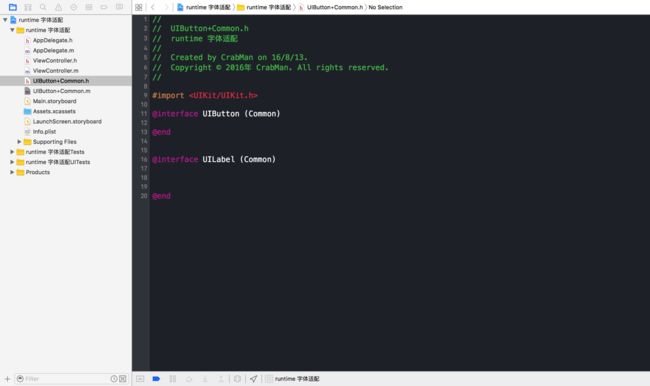上篇主要是runtime的理论基础(地址请戳这里),但是具体到项目中的时候很少会想到使用runtime来解决问题,本文主要根据笔者在项目中的某些需求,将使用runtime的某些场景记录下来。
1 修改UITextField中placeholder的颜色以及文字大小
项目需求:textFiled为镂空显示父视图的背景色,placeholder的颜色为白色,切字体字号为22px
1.1 解决问题思路
查看UITextField的属性发现并没有相关设置的属性,使用runtime遍历UITextField的属性遍历,并通过次变量修改placeholder的颜色和字体大小.
unsigned int count;
Ivar *ivarList = class_copyIvarList([UITextField class], &count);
for (int i = 0 ; i < count; i++) {
Ivar ivar = ivarList[i];
NSString *name = [NSString stringWithUTF8String:ivar_getName(ivar)];
//将第一个字符截取掉,获得属性名
NSString *propertyName = [name substringFromIndex:1];
//前面为成员变量,后面为属性名
NSLog(@"%@:%@",name,propertyName);
}
查看控制台打印结果(可以通过command+F搜索):
1.2 解决问题
UITextField *textFiled = [[UITextField alloc]initWithFrame:CGRectMake(0, 200, self.view.frame.size.width, 40)];
textFiled.backgroundColor = [UIColor clearColor];
textFiled.layer.borderColor = [UIColor whiteColor].CGColor;
textFiled.layer.borderWidth = 1;
textFiled.layer.cornerRadius = 4;
textFiled.placeholder = @"我是重生的占位符";
[textFiled setValue:[UIColor whiteColor] forKeyPath:@"_placeholderLabel.textColor"];
[textFiled setValue:[UIFont systemFontOfSize:11] forKeyPath:@"_placeholderLabel.font"];
[self.view addSubview:textFiled];
1.3 效果展示
但是该属性变量属于苹果的私有API,使用该方法上线有可能会被拒,慎用.
2 项目中navigationBar的backItem不显示文字
需求:项目中的大部分navigationBar的backItem不需要文字,只需要返回箭头.
2.1 在不需要backItem文字的视图控制器被push之前,设置backItem
UIBarButtonItem *backItem = [[UIBarButtonItem alloc]init];
backItem.title = @"";
self.navigationItem.backBarButtonItem = backItem;
设置该方法需要注意两点:需要在Push之前这是backBarButtonItem,否则无效;必须初始化一个新的UIBarButtonItem对象,设置其title为空并赋值,直接设置backBarButtonItem.title无效
页面多的话,可以设置BaseController在其中设置,新生成的Controller继承即可.
2.2 使用runtime解决
但是总觉的方法一这个不是解决问题的完美方法,想找到一个完美实现该需求且一劳永逸的方法。
使用category为UINavigationController增加扩展方法
//在程序启动时,使用runtime交换系统与自定义的方法
+(void)load{
static dispatch_once_t onceToken;
dispatch_once(&onceToken, ^{
Method originalMethod = class_getInstanceMethod(self, @selector(backBarButtonItem));
Method customMethod = class_getInstanceMethod(self, @selector(CM_BackBarButtonItem));
method_exchangeImplementations(originalMethod, customMethod);
});
}
static char CMCustomBackBarButtonKey;
-(UIBarButtonItem *)CM_BackBarButtonItem{
UIBarButtonItem *item = [self CM_BackBarButtonItem];
if (item) {
return item;
}
item = objc_getAssociatedObject(self, &CMCustomBackBarButtonKey);
if (!item) {
item = [[UIBarButtonItem alloc] initWithTitle:@"" style:UIBarButtonItemStylePlain target:nil action:NULL];
objc_setAssociatedObject(self, &CMCustomBackBarButtonKey, item, OBJC_ASSOCIATION_RETAIN_NONATOMIC);
}
return item;
}
2.3 效果展示
3 字体适配
项目中字体适配是很常见的情况,主要适配6p机型,常见的适配方法是在设置字体大小的时候乘以一个宏定义比例,该方法需要在每次设置字体的时候都要乘以比例,比较繁琐.
runtime可以通过自定义的方法替换系统方法,因此又想到了runtime
3.1 解决思路:
需要设置字体大小的控件为UILabel和UIButton,通过分类分别为两个类扩展方法,自定义方法在子视图加载之前重新设置控件的字体大小(通过判断是否为6p乘以一个自定义的比例)
3.2 解决方法:
@implementation UIButton (Common)
+ (void)load {
//方法交换应该被保证,在程序中只会执行一次
static dispatch_once_t onceToken;
dispatch_once(&onceToken, ^{
SEL systemSel = @selector(willMoveToSuperview:);
SEL swizzSel = @selector(CM_WillMoveToSuperview:);
Method systemMethod = class_getInstanceMethod([self class], systemSel);
Method swizzMethod = class_getInstanceMethod([self class], swizzSel);
//首先动态添加方法,实现是被交换的方法,返回值表示添加成功还是失败
BOOL isAdd = class_addMethod(self, systemSel, method_getImplementation(swizzMethod), method_getTypeEncoding(swizzMethod));
if (isAdd) {
//如果成功,说明类中不存在这个方法的实现
//将被交换方法的实现替换到这个并不存在的实现
class_replaceMethod(self, swizzSel, method_getImplementation(systemMethod), method_getTypeEncoding(systemMethod));
} else {
//否则,交换两个方法的实现
method_exchangeImplementations(systemMethod, swizzMethod);
}
});
}
- (void)CM_WillMoveToSuperview:(UIView *)newSuperview {
[self CM_WillMoveToSuperview:newSuperview];
// if ([self isKindOfClass:NSClassFromString(@"UIButtonLabel")]) {
// return;
// }
if (self) {
//不需要适配的,通过设置tag值跳过
if (self.tag != 10086) {
self.titleLabel.font = [UIFont systemFontOfSize:self.titleLabel.font.pointSize*SizeScale];
} else {
}
}
}
@end
UILable同样可以使用替换系统的方法实现字体的适配.
效果就不展示,具体大家可以自己运行在模拟器查看。
3.3 设计优化
将UILabel的分类和UIButton的分类合并写在一个类里面。
.m文件
/**
button的字体适配
*/
@implementation UIButton (Common)
+ (void)load {
//方法交换应该被保证,在程序中只会执行一次
static dispatch_once_t onceToken;
dispatch_once(&onceToken, ^{
SEL systemSel = @selector(willMoveToSuperview:);
SEL swizzSel = @selector(CM_WillMoveToSuperview:);
Method systemMethod = class_getInstanceMethod([self class], systemSel);
Method swizzMethod = class_getInstanceMethod([self class], swizzSel);
//首先动态添加方法,实现是被交换的方法,返回值表示添加成功还是失败
BOOL isAdd = class_addMethod(self, systemSel, method_getImplementation(swizzMethod), method_getTypeEncoding(swizzMethod));
if (isAdd) {
//如果成功,说明类中不存在这个方法的实现
//将被交换方法的实现替换到这个并不存在的实现
class_replaceMethod(self, swizzSel, method_getImplementation(systemMethod), method_getTypeEncoding(systemMethod));
} else {
//否则,交换两个方法的实现
method_exchangeImplementations(systemMethod, swizzMethod);
}
});
}
- (void)CM_WillMoveToSuperview:(UIView *)newSuperview {
[self CM_WillMoveToSuperview:newSuperview];
// if ([self isKindOfClass:NSClassFromString(@"UIButtonLabel")]) {
// return;
// }
if (self) {
if (self.tag != 10086) {
self.titleLabel.font = [UIFont systemFontOfSize:self.titleLabel.font.pointSize*SizeScale];
} else {
}
}
}
@end
#pragma mark --- 字体设置
@implementation UILabel (Common)
+ (void)load {
//方法交换应该被保证,在程序中只会执行一次
static dispatch_once_t onceToken;
dispatch_once(&onceToken, ^{
SEL systemSel = @selector(willMoveToSuperview:);
SEL swizzSel = @selector(CM_WillMoveToSuperview:);
Method systemMethod = class_getInstanceMethod([self class], systemSel);
Method swizzMethod = class_getInstanceMethod([self class], swizzSel);
//首先动态添加方法,实现是被交换的方法,返回值表示添加成功还是失败
BOOL isAdd = class_addMethod(self, systemSel, method_getImplementation(swizzMethod), method_getTypeEncoding(swizzMethod));
if (isAdd) {
//如果成功,说明类中不存在这个方法的实现
//将被交换方法的实现替换到这个并不存在的实现
class_replaceMethod(self, swizzSel, method_getImplementation(systemMethod), method_getTypeEncoding(systemMethod));
} else {
//否则,交换两个方法的实现
method_exchangeImplementations(systemMethod, swizzMethod);
}
});
}
- (void)CM_WillMoveToSuperview:(UIView *)newSuperview {
[self CM_WillMoveToSuperview:newSuperview];
// if ([self isKindOfClass:NSClassFromString(@"UIButtonLabel")]) {
// return;
// }
if (self) {
if (self.tag != 10086) {
self.font = [UIFont systemFontOfSize:self.font.pointSize*SizeScale];
} else {
}
}
}
@end



